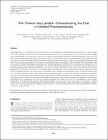| dc.contributor.author | EHRHARDT, CARSTEN | en |
| dc.date.accessioned | 2010-12-20T17:43:56Z | |
| dc.date.available | 2010-12-20T17:43:56Z | |
| dc.date.issued | 2010 | en |
| dc.date.submitted | 2010 | en |
| dc.identifier.citation | JS Patton, JD Brain, LA Davies, J Fiegel, M Gumbleton, KJ Kim, M Sakagami, R Vanbever, C Ehrhardt, The particle has landed - characterizing the fate of inhaled pharmaceuticals, J Aerosol Med Pulm Drug Deliv, 23, S2, 2010, S71-S87 | en |
| dc.identifier.other | Y | en |
| dc.identifier.uri | http://hdl.handle.net/2262/48066 | |
| dc.description | PUBLISHED | en |
| dc.description.abstract | Although there is a modest body of literature on the absorption of inhaled pharmaceuticals by normal lungs and some limited information from diseased lungs, there is still a surprising lack of mechanistic knowledge about the details of the processes involved. Where are molecules absorbed, what mechanisms are involved, how well are different lung regions penetrated, what are the determinants of metabolism and dissolution, and how best can one retard the clearance of molecules deposited in the lung or induce intracellular uptake by lung cells? Some general principles are evident: (1) small hydrophobic molecules are absorbed very fast (within tens of seconds) usually with little metabolism; (2) small hydrophilic molecules are absorbed fast (within tens of minutes), again with minimal metabolism; (3) very low water solubility of the drug can retard absorption; (4) peptides are rapidly absorbed but are significantly metabolized unless chemically protected against peptidases; (5) larger proteins are more slowly absorbed with variable bioavailabilities; and 6) insulin seems to be best absorbed distally in the lungs while certain antibodies appear to be preferentially absorbed in the upper airways. For local lung disease applications, and some systemic applications as well, many small molecules are absorbed much too fast for convenient and effective therapies. For systemic delivery of peptides and proteins, absorption may sometimes be too fast. Bioavailabilities are often too low for cost-effective and reliable treatments. A better understanding of the determinants of pulmonary drug dissolution, absorption, metabolism, and how to target specific regions and/or cells in the lung will enable safer and more effective inhaled medicines in the future. | en |
| dc.description.sponsorship | This conference has been made possible through the
sponsorship of Novartis Pharmaceuticals and AstraZeneca
R&D. C.E. acknowledges funding by a Strategic Research
Cluster Grant (07/SRC/B1154) under the National Development Plan cofunded by EU Structural Funds and
Science Foundation Ireland. K.-J.K. acknowledges funding by
the Whittier Foundation, Hastings Foundation, and National
Institutes of Health. L.A.D. acknowledges funding by the
United Kingdom Cystic Fibrosis Gene Therapy Consortium | en |
| dc.format.extent | S71-S87 | en |
| dc.language.iso | en | en |
| dc.relation.ispartofseries | J Aerosol Med Pulm Drug Deliv | en |
| dc.relation.ispartofseries | 23 | en |
| dc.relation.ispartofseries | S2 | en |
| dc.rights | Y | en |
| dc.subject | Pharmacology and pharmacy | en |
| dc.subject | inhaled pharmaceuticals | en |
| dc.title | The particle has landed - characterizing the fate of inhaled pharmaceuticals | en |
| dc.contributor.sponsor | Science Foundation Ireland (SFI) | en |
| dc.type.supercollection | scholarly_publications | en |
| dc.type.supercollection | refereed_publications | en |
| dc.identifier.peoplefinderurl | http://people.tcd.ie/ehrhardc | en |
| dc.identifier.rssinternalid | 67128 | en |
| dc.identifier.doi | 10.1089/jamp.2010.0836 | en |
| dc.subject.TCDTheme | Cancer | en |
| dc.subject.TCDTheme | Immunology, Inflammation & Infection | en |
| dc.subject.TCDTheme | Nanoscience & Materials | en |
| dc.identifier.rssuri | http://dx.doi.org/10.1089/jamp.2010.0836 | en |
| dc.identifier.orcid_id | 0000-0003-0730-1829 | en |




